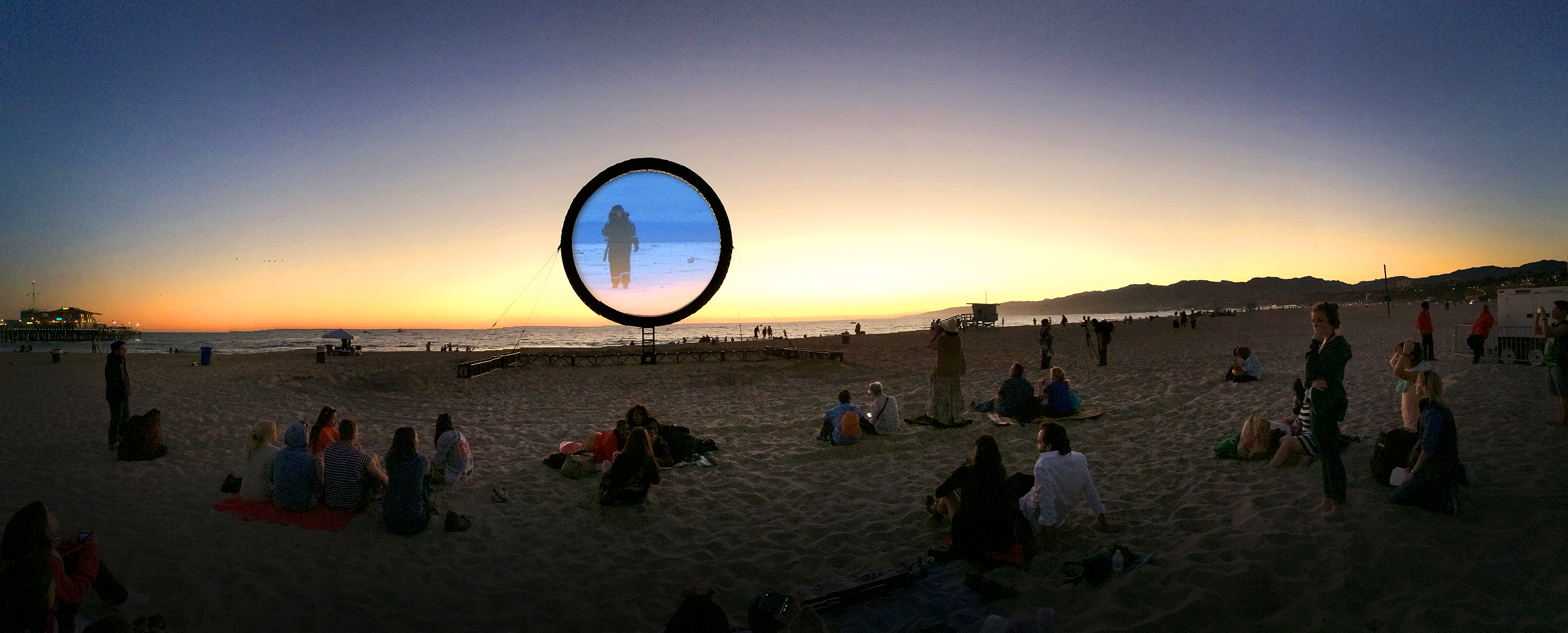CircumSolar is a growing body of artworks based on the arctic tern (Sterna Paradisea), and the space it occupies on our earth and in our imagination. Every year, this small sea bird flies from the arctic to the antarctic and back again, making it the world champion long distance migration. As a result, the arctic tern experiences two polar summers in a year, which makes it the one creature to live the most daylight of any living being.
CircumSolar tracks this migratory journey of traversing our planet –from the top to the bottom and up again – across practically the complete length of our earth’s meridians, carried and guided by the invisible forces of the sun, the moon, the oceanic currents, the hemispherical trade winds, the land’s magnetism, food hotspots, and the overwhelming seasonal call to take flight again. CircumSolar is an encounter with the natural forces that govern our planet embodied by the resilient arctic tern who knows how to harness them.

CircumSolar, Migration 1 (2013), a commission from the City of Santa Monica for an art installation of a 26-minute video first shown on the beach of Santa Monica on a 25 ft diameter screen during the triennial international art event Glow 2013.


It was just in 2010 that ornithologists were first able to accurately track the arctic tern’s flight path, which revealed the bird travels a distance of over 50,000 miles a year, twice as much as previously assumed. The tiny seabird is too light to carry a device that transmits GPS coordinates, and instead it has to be ringed during its boreal breeding season with a geolocator bracelet weighing just one gram and that contains a light sensor and a clock. Daily this device records the time relative to GMT of sunrise or sunset, and the time at which the sun is directly overhead. With this data it is possible to calculate and map the longitude and latitude at a given time. Not only does the bird have to survive the perils of its bipolar migratory journey, so does the geolocator technology, which can only be retrieved a year later by catching the same bird on its nest in a colony that could count thousands of very upset birds who organize to attack in packs to keep intruders out. Since the geolocators—developed by the British Antarctic Survey— became available, there have been three published reports by ornithologists who at different locations have managed a total of 38 successful chip retrievals, offering fascinating new insights into the forces and resources of nature that guide the path the arctic tern takes to not only survive, but to thrive on its record-shattering migration.
The three studies performed so far; in Alaska, in Greenland and in The Netherlands, have each charted surprisingly different routes taken across our globe south, each of its own epic proportions, where the Alaskan birds at one point cross over the 15,000 feet high Andes mountains, from Chile to Argentina; and some of the Dutch terns make it all the way to New Zealand before heading to the Antarctic south. Life for an arctic tern starts in the boreal summer around the Arctic Circle, the only time of the year the birds make land, to nest in loud colonies on sand banks and marshes, never far from water. In August the young birds, barely two-months old, take flight to the other side of the planet. The birds from Greenland and Iceland go on a mid-Atlantic route in small packs, across the length of the Atlantic Ocean, stopping at food hotspots along the way, flying past Western Europe downward along the coast of Africa. Some hop continents to the eastern point of Brazil and weave their way down to Tierra del Fuego; most take Cape Hope in South Africa as jumping off point toward the latitudes of the roaring forties, through the furious fifties and onto the shrieking sixties, to arrive at the edge of the polar drift ice zone in the Southern Ocean, the southernmost destination of the tern’s epic journey. The fall migration takes the birds on average about 80 days. The spring migration north is a different route and takes only half the time. Starting from the Weddell Sea the terns jump onto the trade winds that propel them north and west over the mid-Atlantic Ridge, passing the islands of Tristan da Cunha, St.Helena (where Napoleon was banned), Ascension (where Darwin and fellow British biologists turned a barren volcanic rock into a man made Garden of Eden), and crossing the equator to Cape Verdes by the coast of Africa, past the Azores, back north again. The CircumSolar project is comprised of artworks in multiple media, one will be cartography, a series of artistic maps detailing the arctic tern migration.
Unfortunately, the arctic tern is also the proverbial canary in the coalmine, the herald of times that are changing before our very eyes. On a field trip to Iceland in 2013 I met with Dr. Freydis Vigfusdottir of the University of Exeter, UK and the Icelandic Institute of Natural History, who conducted a five-year study on the arctic tern. Her research in the Snaefellsnes peninsula showed 90% of the chicks died in the first month after birth due to starvation. This is partly caused by the warming by one degree of the ocean surrounding Iceland, resulting in the mackerel migrating north a month earlier, which feeds on the same sand eel that the arctic tern chicks rely on. The consequences are grim. The arctic tern can live to over 30 years old. If there are a million pairs of arctic tern in the world, a quarter of those nest in Iceland, and a quarter of that on the peninsula; with these reproduction rates, how soon before they become endangered, even extinct? I gathered written testimonials from the ‘Kria Folk,’ the local population of Rif in the Snaefellsnes peninsula who have lived among the ‘kria’ —arctic tern in Icelandic— for generations. The thread that runs through the stories is that the population of arctic terns has diminished dramatically. CircumSolar gives me the platform to reflect on how we as human species seem to no longer have an understanding of our place within the greater scheme of life. I believe we, humans, have lost our impetus towards evolution.
Within the discipline of art, my CircumSolar project is considered artistic fieldwork practice, often referred to as planetary art, where artistic projects are based on field investigation methods and concern issues of post-humanism, speculative realism, the anthropocene and geo-aesthetics. Artistic fieldwork, borrows methods from various disciplines—from sociology to fiction writing, and merges the objectivity of scientific research with a subjective, flexible approach, drawing on multiple methodologies and discourses. Artists engage in explorations surveying the earth, investigating things in the field, and their projects often take the form of atypical archives, presenting the results of their research in the form of films, photographs, installations, animations, drawings, and text.


The CircumSolar project has been under development since my third field trip to Iceland in 2013, when I used funds earned with the Pico Rivera Library artwork and the commission granted by the City of Santa Monica for Glow 2013 to spend a two month art residency in the north of Iceland. Several artworks were created during the residency and from the content gathered. Completed artworks within this project are CircumSolar, Migration 1 (2013), a commission from the City of Santa Monica for an art installation of a 26-minute video first shown on the beach of Santa Monica on a 25 ft diameter screen during the triennial international art event Glow 2013. CircumSolar, Migration 2 (2014) is a 132 feet long and 25 ft high mural in the library of Pico Rivera, for the Los Angeles County Arts Commission. CircumSolar, Migration 3, a 17-minute architectural scale projection, was part of the 2014/15 exhibition REALSPACE at the Williamson Gallery in Pasadena, alongside Jennifer Steinkamp and NASA’s Dan Goods, where gallery director and curator Stephen Nowlin bridges art, science and technology. The photographic work Circum/bi/polar 1 (2010)—showing the arctic tern in flight—was exhibited prominently in the Municipal Art Gallery for the 2013 City of Los Angeles (C.O.L.A) Award Individual Artist Fellowship. These works have received international recognition and have been published widely.
In the C.O.L.A. exhibition catalogue MOCA senior curator Alma Ruiz writes about this work: “CircumSolar is a visual study of the understanding of human existence and its interconnection with the earth, as well as an attempt to come to terms with this relationship. According to Mén-dez, her expeditions to the polar region have led her to see the world in more precise ways than ever before: observing the arctic tern’s behavior has sharpened her awareness not only of life’s vulnerability but also of the ability of living creatures to triumph over extreme circumstances. By taking the bird as the subject of an ongoing art project, she aims to draw parallels between its life and her own. CircumSolar is one more step in this direction.”
Technologies such as satellites, Global Positioning and resulting tools such as Google Earth and Google Maps have changed our relationship to finding our way and locating ourselves at a place in space. Mediated by technology we have been offered a different point of view, to see our planet anew, through the eyes of others. In a posthumanist world we need new protagonists, and a gracious figure such as the arctic tern pres-ents an aspirational character who with its resilient and intelligent use of the mighty forces of nature finds its way from practically pole to pole, the undisputed world champion in long distance migration, an unsung hero whose story must be told. To find our way forward, to a evolve as a species, we stand to learn and benefit from the arctic tern. I must observe, measure, document, map and chart the arctic terns’ existence before it is irreversible undone by the man-made folly of climate change.


CircumSolar is a project larger than myself and I'm prepared to present it as an open practice in fieldwork, where the subject matter of the arctic tern is addressed in works by ourselves, as well as artists who are equally inspired by its magnificence. CircumSolar will be a web journal holding a public and shared collection of created, curated and contributed scientific and artistic works revolving around the arctic tern, and the force of migration that it represents. The website compiles together the data of all individual routes flown from birds worldwide. The archive engages the public with eyewitness accounts and artifacts of an untold and unfolding story of mythical proportions. An open invitation is extended to the public to share encounters with the arctic tern and help map its trajectories. A set of instructions is available for anyone to follow in order to enrich the research.


In my capacity of founder and director of the CounterForce Lab, I have an unwavering commitment to research and create works surrounding issues concerning our environment. The CircumSolar project is a pillar of the open practice philosophy of my Center, which engages the next generation of designers and artists to take action on the fundamental changes environmental stresses will impose on society; cultivates an interdisciplinary discussion around the environment and the arts; and fosters ‘fieldwork’ as an artistic practice. The Center provides infrastructure and knowledge to enable artists, designers, and scientists to develop new collaborative insights, disciplines and methods to research, create, design and execute projects around fieldwork, geo-aesthetics, speculative realism, post-humanism and anthropogenic climate change.
previous
next
